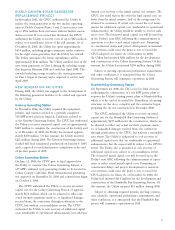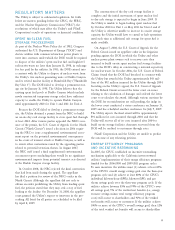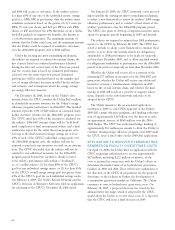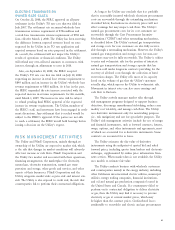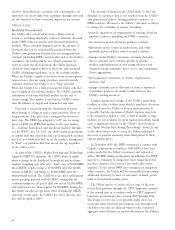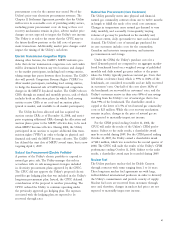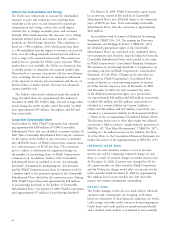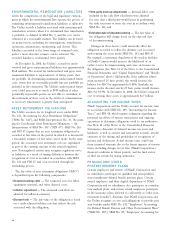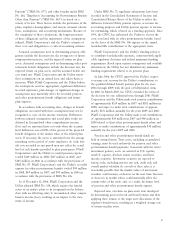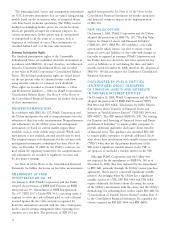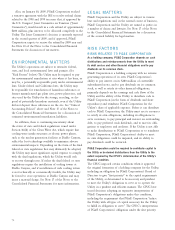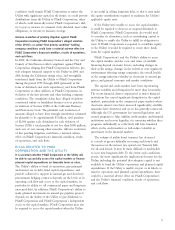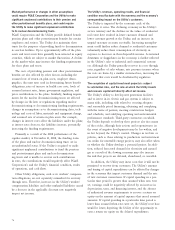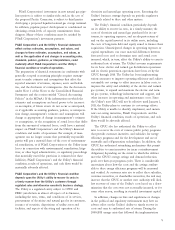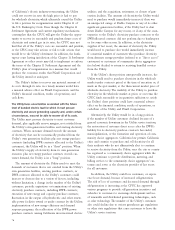PG&E 2008 Annual Report Download - page 68
Download and view the complete annual report
Please find page 68 of the 2008 PG&E annual report below. You can navigate through the pages in the report by either clicking on the pages listed below, or by using the keyword search tool below to find specific information within the annual report.66
• Third-party mark-up adjustments — Internal labor costs
included in the cash fl ow calculation were adjusted
for costs that a third party would incur in performing
the tasks necessary to retire the asset in accordance with
SFAS No. 143; and
• Estimated date of decommissioning — The fair value of
the obligation will change based on the expected date
of decommissioning.
Changes in these factors could materially affect the
obligation recorded to refl ect the ultimate cost associated
with retiring the assets under SFAS No. 143 and FIN 47.
For example, a premature shutdown of the nuclear facilities
at Diablo Canyon would increase the likelihood of an
earlier start to decommissioning and cause an increase in
the obligation. (See Note 13 of the Notes to the Consolidated
Financial Statements and “Capital Expenditures” and “Results
of Operations” above.) Additionally, if the infl ation adjust-
ment increased 25 basis points, this would increase the
balance for ARO by approximately 0.81%. Similarly, an
increase in the discount rate by 25 basis points would decrease
ARO by 0.57%. At December 31, 2008, the Utility’s estimated
cost of retiring these assets is approximately $1.7 billion.
ACCOUNTING FOR INCOME TAXES
PG&E Corporation and the Utility account for income taxes
in accordance with SFAS No. 109, “Accounting for Income
Taxes,” and FIN 48, which requires judgment regarding the
potential tax effects of various transactions and ongoing
operations to determine obligations owed to tax authorities.
(See Note 10 of the Notes to the Consolidated Financial
Statements.) Amounts of deferred income tax assets and
liabilities, as well as current and noncurrent accruals, involve
estimates of the timing and probability of recognition of
income and deductions. Actual income taxes could vary
from estimated amounts due to the future impacts of various
items, including changes in tax laws, PG&E Corporation’s
fi nancial condition in future periods, and the fi nal review
of fi led tax returns by taxing authorities.
PENSION AND OTHER
POSTRETIREMENT PLANS
Certain employees and retirees of PG&E Corporation and
its subsidiaries participate in qualifi ed and non-qualifi ed
non-contributory defi ned benefi t pension plans. Certain
retired employees and their eligible dependents of PG&E
Corporation and its subsidiaries also participate in contribu-
tory medical plans, and certain retired employees participate
in life insurance plans (referred to collectively as “other post-
retirement benefi ts”). Amounts that PG&E Corporation and
the Utility recognize as costs and obligations to provide pen-
sion benefi ts under SFAS No. 158, “Employers’ Accounting
for Defi ned Benefi t Pension and Other Postretirement Plans”
(“SFAS No. 158”); SFAS No. 87, “Employers’ Accounting for
ENVIRONMENTAL REMEDIATION LIABILITIES
Given the complexities of the legal and regulatory environ-
ment in which the environmental laws operate, the process of
estimating environmental remediation liabilities is subjective.
The Utility records a liability associated with environmental
remediation activities when it is determined that remediation
is probable, as defi ned in SFAS No. 5, and the cost can be
estimated in a reasonable manner. The liability can be based
on many factors, including site investigations, remediation,
operations, maintenance, monitoring, and closure. This
liability is recorded at the lower range of estimated costs,
unless a more objective estimate can be achieved. The
recorded liability is re-examined every quarter.
At December 31, 2008, the Utility’s accrual for undis-
counted and gross environmental liabilities was approximately
$568 million. The accrual for undiscounted and gross envi-
ronmental liabilities is representative of future events that
are probable. In determining maximum undiscounted future
costs, events that are reasonably possible but not probable are
included in the estimation. The Utility’s undiscounted future
costs could increase to as much as $944 million if other
potentially responsible parties are not able to contribute to
the settlement of these costs or the extent of contamination
or necessary remediation is greater than anticipated.
ASSET RETIREMENT OBLIGATIONS
The Utility accounts for its long-lived assets under SFAS
No. 143, “Accounting for Asset Retirement Obligations”
(“SFAS No. 143”), and FASB Interpretation No. 47, “Account-
ing for Conditional Asset Retirement Obligations — An
Interpretation of SFAS No. 143” (“FIN 47”). SFAS No. 143
and FIN 47 require that an asset retirement obligation be
recorded at fair value in the period in which it is incurred if
a reasonable estimate of fair value can be made. In the same
period, the associated asset retirement costs are capitalized
as part of the carrying amount of the related long-lived
asset. Rate-regulated entities may recognize regulatory assets
or liabilities as a result of timing differences between the
recognition of costs as recorded in accordance with SFAS
No. 143 and FIN 47 and costs recovered through the
ratemaking process.
The fair value of asset retirement obligations (“ARO”)
is dependent upon the following components:
• Decommissioning costs — The estimated costs for labor,
equipment, material, and other disposal costs;
• Infl ation adjustment — The estimated cash fl ows are
adjusted for infl ation estimates;
• Discount rate — The fair value of the obligation is based
on a credit-adjusted risk-free rate that refl ects the risk
associated with the obligation;



